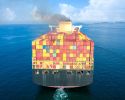The Environmental Protection Agency: The climate goals can be reached

The conditions for Sweden to succeed in climate change have improved in several respects. This according to the Environmental Protection Agency's documentation for the government's climate policy action plan. Among other things, tougher demands on shipping will have an effect.
The Environmental Protection Agency annually prepares documentation for the government's climate report that describes the assessment of the possibility of meeting the climate targets for 2030, 2040 and 2045. This year's documentation presented last week shows that Sweden is significantly closer to reaching the goal of net zero emissions by 2045 compared to corresponding assessments in previous reports . The reduced emission gap is due to a combination of increased ambitions in the EU, that the action alternatives have become more and cheaper and that there is an increased willingness to invest in business.
“In order to take advantage of these conditions, climate policy needs to be given a prominent role in all relevant policy areas. Long-term political decisions are required that have a broad foundation and last over time”, says Stefan Nyström, head of the Environmental Protection Agency's climate department in a press release.
Sweden's emissions have decreased by 33 percent since 1990, and emissions are now estimated to decrease by around 70 percent by 2045.
However, the national milestone target for 2030 will not be reached – not if the government implements and maintains the announced abortment of the reduction obligation on diesel and petrol. With a reduced reduction obligation, it will also be more difficult for Sweden to meet its emission commitment towards the EU, the report states.
So what does the report say about shipping? First of all that the steering towards reduced emissions of greenhouse gases for inland shipping has so far been weak compared to road traffic. Emissions from domestic shipping were 0.6 million tonnes of carbon dioxide equivalents in 2021, which corresponds to just over 4 percent of emissions within domestic transport. The emissions in 2021 were nearly 40 percent higher compared to 1990, and commercial shipping accounts for nearly 75 percent of the emissions.
Going forward, however, there will be higher demands on shipping as well. Within the UN's international maritime organization IMO, a global zero-emissions goal by the year 2050 is now being discussed, which is expected to be decided on in June. However, the EU has already taken some important steps. As recently as Tuesday (read the article here), the decision to include shipping in the EU's trading with emissions rights was hammered out in full from 2026 and previously decisions have been made to limit the greenhouse gas intensity of the fuels used on board (FuelEU Maritime).
So what effects will this have? An introduction of a kind of reduction obligation for shipping fuel, FuelEU Maritime, will affect approximately half of the fuel used for domestic shipping. Calculations carried out by the Swedish Environmental Protection Agency show that the proposal means that the emissions of greenhouse gases from inland shipping will decrease by just under 4 percent by the year 2030 and by just over 30 percent by the year 2045 (this based on a simplified scenario where the emissions from inland shipping and its subgroups remain unchanged until year 2045).
Shipping's inclusion within the EU ETS will also result in a further increased fuel cost for shipping. An introduction of the proposals on FuelEU Maritime and shipping within the EU ETS is estimated by the Environmental Protection Agency to reduce emissions from domestic shipping by approximately 7 percent by 2030 and 35 percent by 2045.
-
 NextWave – en podd som ska locka unga
NextWave – en podd som ska locka unga -
 Ny studie: Eldrivna pendelbåtar kan effektivisera Stockholms kollektivtrafik
Ny studie: Eldrivna pendelbåtar kan effektivisera Stockholms kollektivtrafik -
 Sjöfartens utsläpp ökar
Sjöfartens utsläpp ökar -
 Sociala relationer påverkar val av bränsle
Sociala relationer påverkar val av bränsle -
 Sjöfartens omställning kräver ”mjukare” påtryckningar
Sjöfartens omställning kräver ”mjukare” påtryckningar -
 Hon hade avtalad tid med Kapten ynkrygg
Hon hade avtalad tid med Kapten ynkrygg -
 Lighthouse omvärldsanalys 2025 – osäkerhet och tullar präglar sjöfarten
Lighthouse omvärldsanalys 2025 – osäkerhet och tullar präglar sjöfarten -
 Se seminariet Shipping in the Marine Environment
Se seminariet Shipping in the Marine Environment -
 Vad betyder egentligen de 90 procenten?
Vad betyder egentligen de 90 procenten? -
 Hålla där...
Hålla där...

